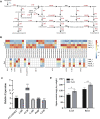Transcriptome Profiling of the Salt Stress Response in the Leaves and Roots of Halophytic Eutrema salsugineum
- PMID: 34868259
- PMCID: PMC8637539
- DOI: 10.3389/fgene.2021.770742
Transcriptome Profiling of the Salt Stress Response in the Leaves and Roots of Halophytic Eutrema salsugineum
Abstract
Eutrema salsugineum can grow in natural harsh environments; however, the underlying mechanisms for salt tolerance of Eutrema need to be further understood. Herein, the transcriptome profiling of Eutrema leaves and roots exposed to 300 mM NaCl is investigated, and the result emphasized the role of genes involved in lignin biosynthesis, autophagy, peroxisome, and sugar metabolism upon salt stress. Furthermore, the expression of the lignin biosynthesis and autophagy-related genes, as well as 16 random selected genes, was validated by qRT-PCR. Notably, the transcript abundance of a large number of lignin biosynthesis genes such as CCoAOMT, C4H, CCR, CAD, POD, and C3'H in leaves was markedly elevated by salt shock. And the examined lignin content in leaves and roots demonstrated salt stress led to lignin accumulation, which indicated the enhanced lignin level could be an important mechanism for Eutrema responding to salt stress. Additionally, the differentially expressed genes (DEGs) assigned in the autophagy pathway including Vac8, Atg8, and Atg4, as well as DEGs enriched in the peroxisome pathway such as EsPEX7, EsCAT, and EsSOD2, were markedly induced in leaves and/or roots. In sugar metabolism pathways, the transcript levels of most DEGs associated with the synthesis of sucrose, trehalose, raffinose, and xylose were significantly enhanced. Furthermore, the expression of various stress-related transcription factor genes including WRKY, AP2/ERF-ERF, NAC, bZIP, MYB, C2H2, and HSF was strikingly improved. Collectively, the increased expression of biosynthesis genes of lignin and soluble sugars, as well as the genes in the autophagy and peroxisome pathways, suggested that Eutrema encountering salt shock possibly possess a higher capacity to adjust osmotically and facilitate water transport and scavenge reactive oxidative species and oxidative proteins to cope with the salt environment. Thus, this study provides a new insight for exploring the salt tolerance mechanism of halophytic Eutrema and discovering new gene targets for the genetic improvement of crops.
Keywords: Eutrema salsugineum; RNA-seq; autophagy; lignin biosynthesis; peroxisome; salt shock; sugar metabolism; transcription factor.
Copyright © 2021 Li, Qi, Zhao, Wang and Zhang.
Conflict of interest statement
The authors declare that the research was conducted in the absence of any commercial or financial relationships that could be construed as a potential conflict of interest.
Figures










Similar articles
-
Divergence in the Regulation of the Salt Tolerant Response Between Arabidopsis thaliana and Its Halophytic Relative Eutrema salsugineum by mRNA Alternative Polyadenylation.Front Plant Sci. 2022 Mar 25;13:866054. doi: 10.3389/fpls.2022.866054. eCollection 2022. Front Plant Sci. 2022. PMID: 35401636 Free PMC article.
-
Eutrema EsMYB90 Gene Improves Growth and Antioxidant Capacity of Transgenic Wheat Under Salinity Stress.Front Plant Sci. 2022 Apr 29;13:856163. doi: 10.3389/fpls.2022.856163. eCollection 2022. Front Plant Sci. 2022. PMID: 35574106 Free PMC article.
-
Adaptative Mechanisms of Halophytic Eutrema salsugineum Encountering Saline Environment.Front Plant Sci. 2022 Jun 28;13:909527. doi: 10.3389/fpls.2022.909527. eCollection 2022. Front Plant Sci. 2022. PMID: 35837468 Free PMC article. Review.
-
Comparative Transcriptome Profiling Provides Insights into Plant Salt Tolerance in Watermelon (Citrullus lanatus).Life (Basel). 2022 Jul 12;12(7):1033. doi: 10.3390/life12071033. Life (Basel). 2022. PMID: 35888121 Free PMC article.
-
Lipid remodelling: Unravelling the response to cold stress in Arabidopsis and its extremophile relative Eutrema salsugineum.Plant Sci. 2017 Oct;263:194-200. doi: 10.1016/j.plantsci.2017.07.017. Epub 2017 Jul 27. Plant Sci. 2017. PMID: 28818375 Free PMC article. Review.
Cited by
-
The Halophyte Dehydrin Sequence Landscape.Biomolecules. 2022 Feb 19;12(2):330. doi: 10.3390/biom12020330. Biomolecules. 2022. PMID: 35204830 Free PMC article.
-
Comprehensive transcriptome analysis of Asparagus officinalis in response to varying levels of salt stress.BMC Plant Biol. 2024 Aug 30;24(1):819. doi: 10.1186/s12870-024-05540-4. BMC Plant Biol. 2024. PMID: 39215284 Free PMC article.
-
Genome-wide analysis of annexin gene family in Schrenkiella parvula and Eutrema salsugineum suggests their roles in salt stress response.PLoS One. 2023 Jan 18;18(1):e0280246. doi: 10.1371/journal.pone.0280246. eCollection 2023. PLoS One. 2023. PMID: 36652493 Free PMC article.
-
The regulation of plant cell wall organisation under salt stress.Front Plant Sci. 2023 Mar 10;14:1118313. doi: 10.3389/fpls.2023.1118313. eCollection 2023. Front Plant Sci. 2023. PMID: 36968390 Free PMC article. Review.
-
Autophagy in plants.Autophagy Rep. 2024 Oct 15;3(1):2395731. doi: 10.1080/27694127.2024.2395731. eCollection 2024. Autophagy Rep. 2024. PMID: 40395529 Free PMC article. Review.
References
LinkOut - more resources
Full Text Sources
Research Materials
Miscellaneous

